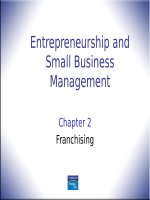Entrepreneurship and smaill business management chapter 02
Bạn đang xem bản rút gọn của tài liệu. Xem và tải ngay bản đầy đủ của tài liệu tại đây (86.57 KB, 14 trang )
Entrepreneurship and
Small Business
Management
Chapter 2
Franchising
Ch. 2 Performance
Objectives
Define and describe franchising.
Identify the positive and negative aspects
of franchising.
Understand the structure of the franchise
industry.
Recognize the legal aspects of franchising.
Learn how to research franchise
opportunities.
Explore international franchising.
Entrepreneurship and Small Business
Management, 1/e
2
© 2012 Pearson Education, Upper Saddle River, NJ
07458.
What Is Franchising?
Franchise—a business that markets a
product/service developed by a franchisor
Franchising—the system of operating a
franchise governed by a legal agreement
Franchisor—person or company who
develops/sells a franchise and specifies
the terms and methods of the agreement
Franchisee—owner of a franchise unit or
territory rights
Entrepreneurship and Small Business
Management, 1/e
3
© 2012 Pearson Education, Upper Saddle River, NJ
07458.
Main Types of Franchises
Product and trade-name
franchising—licensing or production
of the product, and use of the
franchise trade mark, logo, or
identity
Business-format franchising—
purchase of an entire business model
and system, including access to
management expertise
Entrepreneurship and Small Business
Management, 1/e
4
© 2012 Pearson Education, Upper Saddle River, NJ
07458.
Other Franchise Variations
Master franchise—allows
individuals and organizations to buy
the right to sub-franchise within a
defined geographic territory
Area franchise or multiple-unit
franchise—gives exclusive rights to
open franchisee-operated units
within specific areas
Entrepreneurship and Small Business
Management, 1/e
5
© 2012 Pearson Education, Upper Saddle River, NJ
07458.
Positive and Negative
Aspects of Franchising
Advantages
Start-up assistance
Instant recognition
Purchasing power
Advertising and
promotional support
Operating guidelines
Record of success
Entrepreneurship and Small Business
Management, 1/e
6
Drawbacks
Constraints on
creativity and
freedom
Costs
Standards and
obligations
© 2012 Pearson Education, Upper Saddle River, NJ
07458.
Franchise Industry
Structure
A few large franchisors, with
worldwide franchisees, control
most of the industry.
Many smaller franchisors have
local and regional franchisees.
U.S. franchises provide over 9.5
million jobs.
Entrepreneurship and Small Business
Management, 1/e
7
© 2012 Pearson Education, Upper Saddle River, NJ
07458.
Additional Types of
Franchises
Internet franchise—”virtual” franchise
that is not dependent on a physical
location
Conversion franchising—an existing
stand-alone business or local chain
becomes part of a franchise operation
Piggybacking or co-branding—two
franchises share locations and resources
Entrepreneurship and Small Business
Management, 1/e
8
© 2012 Pearson Education, Upper Saddle River, NJ
07458.
Legal Aspects of
Franchising
State and federal regulations govern
franchises.
Federal Trade Commission (FTC)—
primary agency involved in oversight
Franchise Disclosure Document (FDD)
—primary source of data for prospective
franchisees regarding franchisors
Franchise agreement—legal contract
between the parties in a franchise
Entrepreneurship and Small Business
Management, 1/e
9
© 2012 Pearson Education, Upper Saddle River, NJ
07458.
Information Included in a FDD
Overview and background
Fees and costs
Contractual obligations
Territory
Financial performance
Data on existing units
Financial statements and contracts
Termination, renewal, and other
policies
Entrepreneurship and Small Business
Management, 1/e
10
© 2012 Pearson Education, Upper Saddle River, NJ
07458.
Information Included in a
Franchise Agreement
Term of agreement (length of time)
Standards of quality and performance
Royalties
Non-compete, “hold harmless,” and
integration clauses; choice of venue
Clauses regarding termination,
renewal, and transfer of the franchise
Territories
Entrepreneurship and Small Business
Management, 1/e
11
© 2012 Pearson Education, Upper Saddle River, NJ
07458.
Steps for Franchise Selection
1.
2.
3.
4.
5.
Take time to reflect and engage
core supporters.
Identify potential franchises.
Do research to narrow the list
of options.
Decide if to use a franchise
broker.
Visit and observe franchise
operator(s).
Entrepreneurship and Small Business
Management, 1/e
12
© 2012 Pearson Education, Upper Saddle River, NJ
07458.
Steps for Franchise Selection
(continued)
6.
7.
8.
9.
10.
Request preliminary information
from franchise companies.
Perform due diligence on a
specific franchise.
Explore financing options.
Make a decision, engage
professional counsel, and
negotiate an agreement.
Make it work!
Entrepreneurship and Small Business
Management, 1/e
13
© 2012 Pearson Education, Upper Saddle River, NJ
07458.
International Franchising
Opportunities exist worldwide.
The decision to go global is more
complex than domestic franchising.
Ethnic, cultural, and religious diversity
impact business format and operations.
Policies must be altered for differences
in governing law and custom.
Entrepreneurship and Small Business
Management, 1/e
14
© 2012 Pearson Education, Upper Saddle River, NJ
07458.









